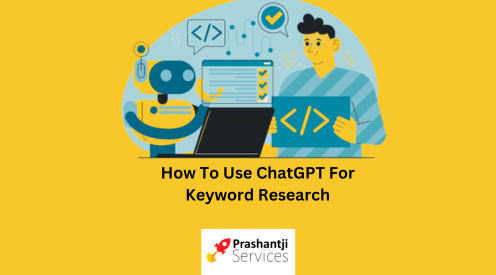At Prashantji Services, we understand the importance of staying ahead in the ever-evolving digital marketing landscape. Utilizing advanced tools and technologies is crucial for maintaining a competitive edge. One such powerful tool is ChatGPT AI, an innovative language model developed by OpenAI. By leveraging ChatGPT AI for keyword research, businesses can uncover valuable insights, enhance their SEO strategies, and drive more organic traffic to their websites. This guide will walk you through the process of using ChatGPT AI to optimize your keyword research efforts effectively.
Understanding ChatGPT AI

ChatGPT AI is an advanced language model that can produce text that is similar to that of a human, and it was developed by OpenAI. It’s designed to respond to input with contextually relevant and coherent text, making it a powerful tool for various applications, including keyword research. By leveraging its extensive training on diverse datasets, ChatGPT AI can provide creative and unique keyword suggestions tailored to specific topics or niches. Its efficiency and adaptability make it an indispensable asset for digital marketers looking to enhance their content strategy and improve SEO performance. With ChatGPT AI, users can uncover valuable keywords and optimize their content for better search engine rankings.
Why Use ChatGPT AI for Keyword Research?
Traditional keyword research tools are still valuable, but ChatGPT AI offers several unique advantages:
- Efficiency: ChatGPT AI can quickly generate a list of relevant keywords based on a given topic, saving time and effort.
- Creativity: The AI’s ability to think outside the box can help uncover unique long tail keywords that might be overlooked by conventional tools.
- Adaptability: ChatGPT AI can be used to tailor keywords to specific niches and audiences, enhancing the relevance of your content.
- Enhanced SEO Performance: Integrating AI-generated keywords into your content can improve your search engine rankings. ChatGPT AI helps identify keywords with a good balance of search volume and competition, optimizing your content for better visibility.
How to Use ChatGPT for Keyword Research
Using ChatGPT AI for keyword research can significantly enhance your digital marketing strategy. Here’s a step-by-step guide to effectively leverage this powerful tool:
Step 1: Define Your Niche and Goals
Clearly define the topic or niche you are targeting. A well-defined topic helps ChatGPT AI generate more accurate and relevant keywords. For instance, if you’re focusing on keyword research in digital marketing, make sure to specify this context to the AI.
Step 2: Input Your Primary Keyword
Start with a primary keywords related to your niche. For example, if your focus is on digital marketing, your seed keywords could be “digital marketing strategies,” “SEO tips,” or “content marketing.” Input these into ChatGPT AI to begin generating a list of related keywords.
Step 3: Generate Long Tail Keywords
ChatGPT AI excels at generating long tail keywords. Enter your primary keyword and let the AI produce a list of related keywords. For example, it might suggest: generate keywords for website, how to find seo keyword, keyword research for seo, keyword research in digital marketing.
Step 4: Analyze and Select Keywords
Once you have a list of keywords, analyze them based on their search volume, SEO difficulty, and relevance to your content. Tools like Keyword Tool IO or other keyword research tools can be helpful here. Focus on keywords with high search volume but lower competition, such as chatgpt api or chatgpt openai.
Step 5: Integrate Keywords into Your Content
Incorporate your chosen keywords naturally into your content. Ensure to bold the primary keyword and long tail keywords at least 10-15 times throughout the article. This practice helps search engines recognize the relevance of your content to these keywords, improving your chances of ranking higher.
Step 6: Optimize Content Structure
Use keywords in strategic places such as:
- Title: Include your primary keyword.
- Headings and Subheadings: Use keywords to improve SEO and readability.
- Meta Descriptions: Ensure your meta descriptions include your primary keyword and a couple of long tail keywords.
- Introduction and Conclusion: Place keywords in the opening and closing paragraphs to reinforce relevance.
Step 7: Monitor and Adjust
Keyword research is an ongoing process. Track the effectiveness of your content with tools like Google Analytics. Regularly update your keywords using ChatGPT AI to keep your content fresh and relevant. Adapt your strategy based on performance metrics and new keyword trends.
Tips for Effective Keyword Integration

Effective keyword integration is crucial for improving your content’s SEO performance and ensuring it resonates with your target audience. Here are some practical tips to help you integrate primary keywords and long tail keywords naturally and effectively:
1. Natural Placement
Avoid keyword stuffing, which can make your content sound forced and reduce readability. Instead, place keywords naturally within the flow of your writing. Ensure that the keywords fit seamlessly into sentences and paragraphs without disrupting the reader’s experience.
2. Use Variations and Synonyms
Incorporate variations and synonyms of your keywords to cover a broader range of search queries and avoid repetition. For example, if your primary keyword is chatgpt ai, you can also use variations like chatgpt artificial intelligence and openai chatgpt.
3. Strategic Keyword Placement
Place keywords in strategic locations within your content to maximize their impact. Important categories for your keyword list are:
- Title: Ensure your primary keyword appears in the title.
- Headings and Subheadings: Use keywords in H1, H2, and H3 tags to improve SEO and help readers navigate the content.
- Introduction: Introduce your primary keyword early in the opening paragraph to signal relevance to search engines.
- Conclusion: Reiterate your primary keyword in the closing paragraph to reinforce the content’s focus.
4. Use Long Tail Keywords
Long tail keywords are less competitive and often more specific, making them valuable for targeting niche audiences. Integrate long tail keywords like generate keywords for website and how to find seo keyword naturally within your content to attract more targeted traffic.
5. Maintain Readability
Always prioritize readability and user experience. Well-integrated keywords should enhance the content, not detract from it. Write in a conversational and engaging tone that keeps readers interested and informed.
Conclusion
Prashantji Services believes in harnessing cutting-edge technology to deliver exceptional digital marketing results. ChatGPT AI has proven to be a game-changer in the realm of keyword research, providing businesses with the tools needed to thrive in a competitive online environment. By integrating ChatGPT AI into your SEO strategy, you can discover a wide array of relevant long-tail keywords, improve your search engine rankings, and attract more targeted traffic to your site. Trust in the expertise of Prashantji Services to guide you through the complexities of digital marketing and achieve your business goals with confidence.








